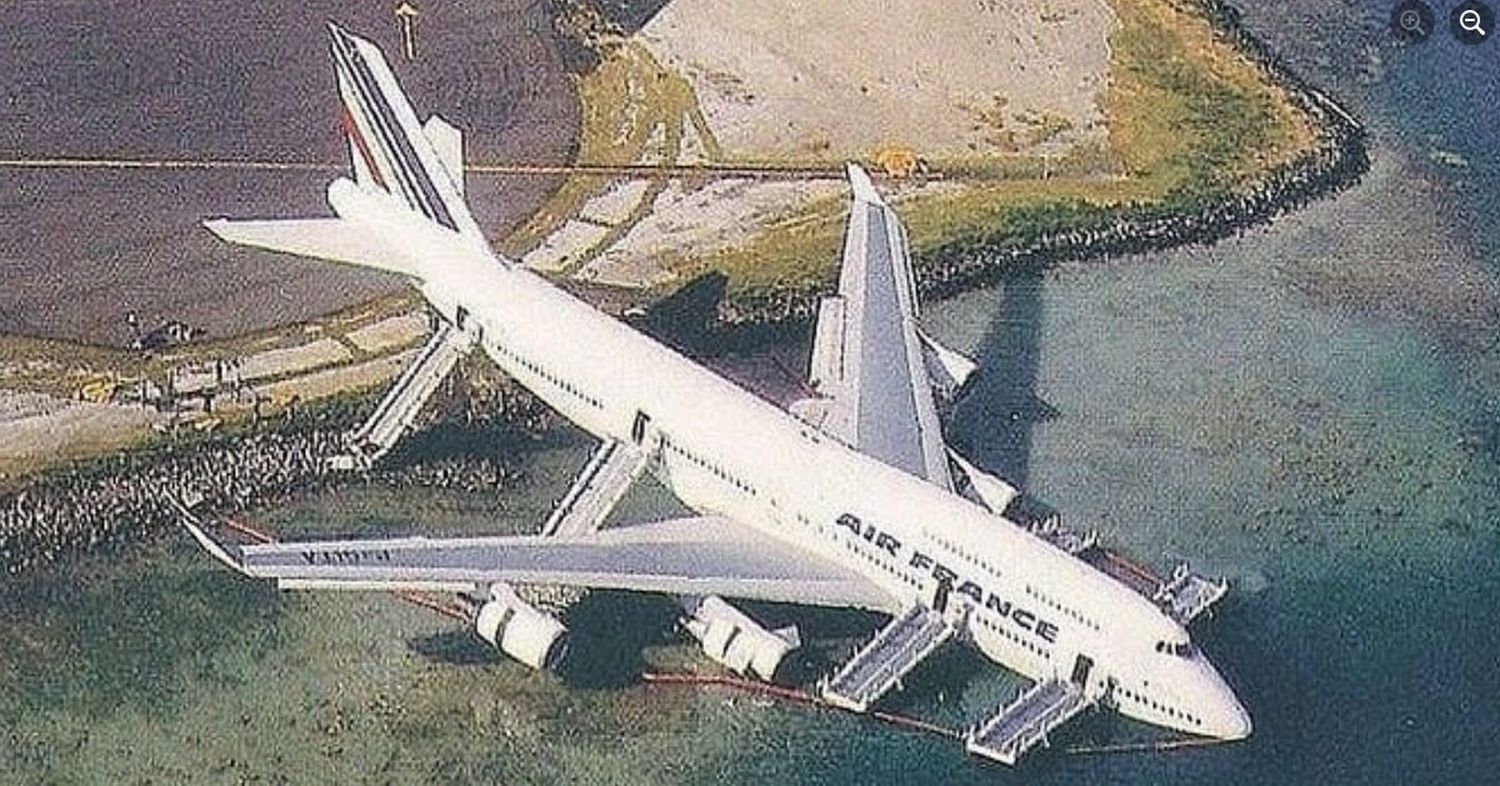30 years after flight 072, Air France’s Boeing 747 runway excursion in Tahiti
On September 12, 1993, a Boeing 747-400 F-GITA of Air France on its Paris-Los Angeles-Tahiti route was involved in an accident that was not only preventable: the chain of events that led to the airplane to end in a lagoon is almost incredible. 30 years later, we dig into the accident to learn a few lessons.
The aircraft, operating under flight number 072, encountered problems during its nighttime approach to Tahiti on runway 22. At the critical moment of landing, the number 1 engine increased its power to 107% N1, disabling the spoilers and automatic brakes. The crew was forced to use only the reverse thrust of engines 2 and 3 to halt the aircraft, resulting in an overrun.


Probable Causes: miscommunication and misjudgement
The accident was attributed to an unstabilized approach and an anomaly in the automatic flight system that activated the go-around mode at the decision height. This, coupled with a long touchdown at an excessive speed and a deviation to the right, caused the aircraft to exit the runway laterally.
In the analysis of the approach and landing of flight F-GITA a series of operational and communicative shortcomings within the crew were identified. The pre-landing briefing was insufficient and lacked a detailed discussion regarding the roles and responsibilities of each pilot, leading to a compromised distribution of tasks during critical phases.
The communication between the pilots was inadequate, partly due to the captain’s hearing issues, hindering a seamless exchange of vital information. The situation was exacerbated by the relaxed atmosphere fostered by the early landing clearance and the visibility of the runway from a distance, which potentially resulted in diminished vigilance.
During the critical moments of the approach and landing, there was a significant lack of focus on the instruments that were crucial in indicating unfolding anomalies. The crew primarily relied on outside visual references, neglecting the necessary monitoring of onboard instruments which could have signaled the increasing thrust and speed deviation.
This lapse in attention culminated in a delayed response to the critical issues that developed during the descent. Moreover, there was an apparent lack of readiness to execute a go-around, a standard procedure to rectify approach anomalies, indicating a failure to adhere to prescribed procedures.
The incident underscores the complexity of the decision-making process in flight operations. Despite noticing the excessive speed, the decision to initiate a go-around was not taken, which would have been the prudent choice under the circumstances.
(28.45) (PF) «Decision height is decreasing.»
(28.49) (PF) «Ok, in sight.»
(28.53) (PNF) «I’m putting on the headlights.»
(PF) «Please.»
(28.57) (PF) «We are a bit high. Engine speed is increasing.»
(28.59) (Voice System) «Five hundred.»
(29.00) (PNF) «Thrust reference V NAV speed.»
(PF) «Ok, I’m switching… switching to visual, okay?»
(29.06) (Voice System) «Four hundred.»
(29.08) (PNF) «We are above the glidepath.»
(29.09) (PF) «Yeah.»
(29.11) (PNF) «Watch out for the speed, you’re going too fast.»
(29.13) (Voice System) «Three hundred.»
(PNF) «We are going way too fast.»
*Engine speed decreasing*
(29.16) (PF) «One hundred and eighty knots. I don’t have…»
(29.17) (PNF) «What is happening?»
(29.18) (PF) «Ah yeah, because…»
(29.20) (Voice System) «Two hundred.»
(29.21) (PNF) «Ok, disconnect.»
(29.24) (Voice System) «One hundred.»
(29.28) (Voice System) «Fifty.»
(29.28) (Voice System) «Forty.»
(29.29) (Voice System) «Thirty.»
(29.30) (Voice System) «Twenty.»
(29.31) (Voice System) «Ten.»
(29.32) (PNF) «Gently, gently, gently, gently, gently.»
(29.33) *Touchdown (sound of wheels touching the ground)*
(29.34) (PF) «Oh, oh, oh!»
(29.40) (PNF) «What’s happening here?»
(29.42) (PF) «Engage reverse… I don’t know, yeah, yeah.»
(29.44) (PNF) «All reversers, wait.»
(29.47) (PF) «There’s one reverser.» *Engine speed increasing*
(29.48) (PNF) «Pull the reverser once.»
(29.50) (PF) «Reset the reversers.» *Engine speed decreasing*
(29.51) (PNF) «Reset the reversers.»
(29.53) (PF) «Reset the reversers.»
(29.54) (PNF) «There, one reverser didn’t engage.»
(29.55) *Engine speed increasing*
(29.57) (PF) «(…) what’s going on? Be careful, be careful.»
(29.58) *Engine speed decreasing*
(30.01) (PF) «Ouch, ouch, ouch!»
(30.04) (PNF) «(…) but what’s happening (…)»
*Increase in ambient noise similar to leaving the runway*
(30.10) (PF) «(…)! Oh, oh, oh!»
(30.13) (PF) «(…)!»
(30.16) * End of recording*.
The analysis suggests a relaxed atmosphere, possibly fostered by the early landing clearance and a clear visual of the runway, might have contributed to complacency, reducing the level of alertness required during the approach phase.

This was further compounded by potential fatigue and overconfidence stemming from the captain’s experience, which overshadowed the necessity to stick to safety protocols.
Lessons learned: Overconfidence is the mother of all mistakes
The incident stressed how vital is to emphasize strict adherence to protocols and maintain open lines of communication. Crews should be prepared to execute a go-around at any stage of the approach if anomalies arise. Continual training and emphasis on safety protocols are essential to mitigate the risk of similar events occurring in the future.

This incident serves as a reminder of the multifaceted factors influencing flight operations’ decision-making processes and outcomes, highlighting the need for vigilance and readiness to adapt to changing circumstances to safeguard flight operations.


Comentarios
Para comentar, debés estar registrado
Por favor, iniciá sesión